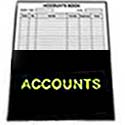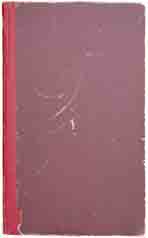
What a working-class family spent its money on in mid-20th Century UK

This page uses a family account book from the 1950s and 60s to list and discuss the general areas of what a working-class English family with one child spent its money on. For how much it spent in each area, see the pages on monthly expenditure and annual expenditure.
____
By the webmaster, based original family documents and inputs from others
The family account book for 1953-1962
My father was a trained accountant who every month conscientiously kept detailed accounts for our household.
We were a family of three - my father, my mother and me, living in a typical three bedroom house in London's suburbia, built in the middle 1930s. The house was owned by us on a mortgage, as was typical of suburban houses of the time, unlike the Victorian terraces where my parents grew up which were rented. Our house was 9 Brook Avenue, Edgware, which at that time was in the county of Middlesex.
The accounts were of course in the old 'pound, shilling and pence' currency, but the value of money has decreased so much since the middle of the 20th century that the main message is carried merely by the number or fractions of pounds (£).
My father's purpose in keeping the accounts was almost certainly simply to aid his management of money - which was tight in the austerity after World War Two. So once an account book was full and a reasonable time had elapsed, it had served its purpose and could be discarded. Consequently most of his account books are lost. The only surviving one is for the years 1953-1962.

My father's family account book for years 1953-1962 - foolscap size.
This account book now has a historical interest, in that it shows:
- how ordinary families spent their money in the middle years of the 20th century
- how the value of money has changed with inflation and
- how accounts were kept before the age of computers.
Unfortunately there is no record of what my father earned before 1956 when his note of his tax return gave his salary as £914-11-0. (There is of course no actual copy of his tax returns because photocopiers were years into the future.)
I do, however, suspect that income and outgoings were reasonably close, because the account book has no category for savings, and money was certainly tight. Furthermore the accounts only showed itemised expenditure and there must have been some which was non-itemised.
The general areas of the financial outgoings
My father's accounts gave what he called 'cash flow' presented under specific key headings which are re-ordered alphabetically for convenience. These show what the money was spent on. For how much was spent, see the pages on monthly expenditure and annual expenditure.
Abbey Road [mortgage]
Bank charges
Birthdays
Car
Christmas and social
Church
Ciggs
Clothes, daughter
Clothes, self
Clothes, wife
Coal and oil
Daughter [university?]
Electricity
Garden
Gas
General rates
Holidays
House furnishing
House repairs
Housekeeping
Insurance [various]
Licences
Loan repaid
Miscellaneous
Season ticket
Self
Telephone
Television
Water rates
Some of these categories did not apply for the entire period, such as 'Daughter [university?] and some started some way into the period. Most, though, changed little and are self-evident, although the following deserve some explanation:
Television
Television as a category first appeared in 1959 - and, in the actual account book, is squeezed into a small space at the top of the list. So 1959 was the first year that our family had a television, and we were by no means unusual. At that time everyone rented rather than bought because televisions used the old valve system, so frequently went wrong. Renting was a form of insurance because the rental company had to foot the repair bills. The rental cost was £11-12-6 in the part year of 1959 and £26-10-8 in the following full year of 1960. All the programmes were in black and white not colour. Televisions were very expensive. Like all electrical goods, they have become much cheaper in real terms over the years.
Mortgage
The old name for the Abbey National Building Society was Abbey Road, and the money in this category represented our mortgage repayments of £4 per month. This amount was agreed back in 1938 when my father bought our house for £835, and it remained fixed throughout the life of the mortgage. I used to go to the Building Society Offices with my mother to pay it in. She handed over four crisp pound notes. (Most bills at that time were paid by personal visit and in cash.)
General rates
General rates were what is now council tax.
Insurance
There were four insurances, but I can only speculate on what they were - probably house insurance, house contents insurance and one or more life insurances. The latter would have been to pay for funeral expenses, which was a usual precaution at that time.
Licences
Two licences were in this category in the early years of the 1950s. One was my father's driving licence which he did not let lapse, even though we did not have a car until 1957. The other was the 'wireless' licence for the radio. In 1959 a television licence was added.
Season Ticket
Season Ticket referred to my father's fare on the London Underground between Edgware Tube Station and his work (Golders Green at first and then central London.) I have no idea what length of time he bought it for.
Cigarettes
'Ciggs' must have been my father's cigarettes. He smoked heavily, as was usual with men at the time. He kept saying that he couldn't afford it and would give it up, but he never did. Perhaps an indication of his embarrassment at that, he turned it into a sort of joke. He was a meticulous man, and no-where else in the records does he use such a curious shorthand. In fact it took me a long time to work out what 'ciggs' meant. I kept reading it as eggs and couldn't understand why they should merit a separate category.
Loan
This loan was repaid during the lifetime of the account book, but beneath the crossing out it seems to say 'schooling'. This puzzles and saddens me, as I went to a state funded grammar school and although my parents did have to buy my school uniform, they would have had to clothe me anyway. I even cycled to school, so there were no travelling costs. (For pupils choosing to use a bus, the council did supply free travel cards for anyone living more than three miles from the school, but I found it simpler to cycle because of the queues, and cycling was door-to-door anyway.)
Car
The car category appeared as a category in 1957. So this must have been the year that we first had a car. This saddens me too because I know that my father longed for one years earlier. He had had one before he was married.
Text and images are copyright
sources: early 20th century material
sources: ww2 home front and other material
contact
the webmaster/author/researcher/editor
privacy policy
















